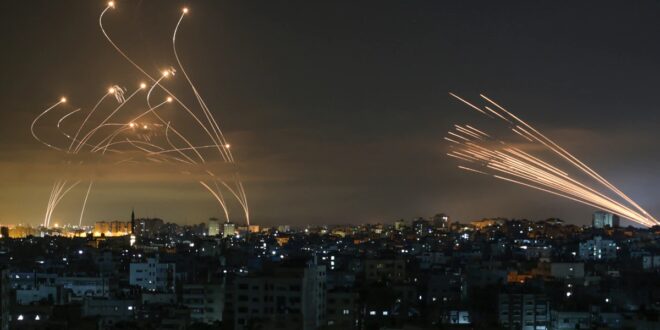Israel’s Iron Dome air defense system has intercepted a drone belonging to the Hamas militant group, a first for the platform, according to the country’s defense forces.
In total, Israel has intercepted six drones using multiple countermeasures since hostilities began between Israel and Hamas on May 10, the Israel Defense Forces said Monday. A senior Air Force officer described the interception as a significant advancement.
Israel touted new capabilities for Iron Dome over the last year, including a drill where it worked alongside other air defense systems to confront multiple threats and another exercise this year during which it downed unmanned aerial systems.
Israeli media on May 13 reported that several drones were launched from the Gaza Strip. An F-16 fighter jet with a Python-5 air-to-air missile downed one of the drones, and an Iron Dome system intercepted another. Other drones were downed by “classified means,” local daily Yediot Ahronot reported.
The IDF on May 13 noted “a short while ago, the Iron Dome Aerial Defense System intercepted a UAV belonging to the Hamas terror organization that crossed from the Gaza Strip into Israeli territory. The Israeli Air Force monitored the UAV until interception. The IDF is continuing to protect Israel’s air space and will not allow activity such as this.” On May 17, the IDF added that this event was the first UAV interception by Iron Dome during combat.
Rafael Advanced Defense Systems, which makes the Iron Dome, would not comment on the interception. The Israeli Defense Ministry, which has released information in the past about new Iron Dome capabilities, also would not comment on the event.
In March, Defense Minister Benny Gantz said “the technological capabilities developed by defense industries, including the Iron Dome and the multi-tier missile defense array, are central to the defense of the State of Israel. In the face of emerging and rapidly changing threats, these new capabilities provide the political echelon and defense establishment with the operational flexibility that is critical to our national security.” At the time, the Israel Missile Defense Organization said “the Iron Dome was tested in a range of complex scenarios and successfully intercepted and destroyed targets simulating existing and emerging threats, including the simultaneous interception of multiple UAVs as well as a salvo of rockets and missiles.”
Since May 10, approximately 3,000 rockets have been fired from the Gaza Strip at Israel. Iron Dome intercepted more than 1,000 of them, representing about 90 percent of those determined to pose a threat. Many rockets fall in open areas or don’t even leave the Gaza Strip due to malfunctions. Hamas UAVs have now been added to the rocket threat.
Tal Inbar, a UAV and aerospace expert as well as the former head of the Space Research Center at the Fisher Institute for Air and Space Strategic Studies, said drones are now an integral part of nonstate actors’ inventories, including those of Hamas and Hezbollah.
“This is a relatively new threat on the battlefield and homefront. You need effective means to intercept them,” explained Inbar, who is now a research fellow at the Missile Defense Advocacy Alliance. He added that this interception illustrates that drones pose a challenge, as they are low flying and have a low radar cross section, but noted that the Iron Dome system has received updates to help it cope with new threats.
Israel uses three terms to refer to drones: malatim or UAVs for larger drones; rakfanim for quadcopters; and kli tais for aircraft, which also is used to refer to Hamas UAVs. Hamas’ use of drones is nothing new, but the group recently unveiled a video of the Shehab, a drone that is launched from a kind of catapult, slinging it into the air where it then flies to its target, apparently along a preprogrammed route. The drone includes a warhead, slamming into the target on a kamikaze mission. This is similar to an Iranian Ababil and the Qasef used by Houthi rebels in Yemen; the latter is based on the former. In September 2019 Iran used a series of kamikaze-style drones and cruise missiles to attack Saudi Arabian oil facilities.
Israel has been working on a number of systems to detect and neutralize drones, including new laser systems and a drone that uses a net to shoot down smaller drones. Rafael has developed lasers to down drones, and the company showed off the ability to intercept numerous small drones during a February 2020 demonstration. Israel has also used planes and helicopters with missiles to address drone threats, including one UAV that flew into Israeli airspace from Syria in February 2018. In July 2018, Israel used a Patriot missile to down a drone from Syria.
The U.S. Army has two Iron Dome system batteries, and the country’s Missile Defense Agency works with Israel on a variety of air defense projects, including the Arrow missile. Congress has also supported counter-drone work with Israel via the fiscal 2019 National Defense Authorization Act. U.S. national security adviser Jake Sullivan and his Israeli counterpart, Meir Ben-Shabbat, discussed cooperation on counter-drone threats in April 2021. A readout of their discussion noted that the “United States and Israel agreed to establish an interagency working group to focus particular attention on the growing threat of unmanned aerial vehicles [UAVs] and precision-guided missiles produced by Iran and provided to its proxies in the Middle East region.”
 Eurasia Press & News
Eurasia Press & News




